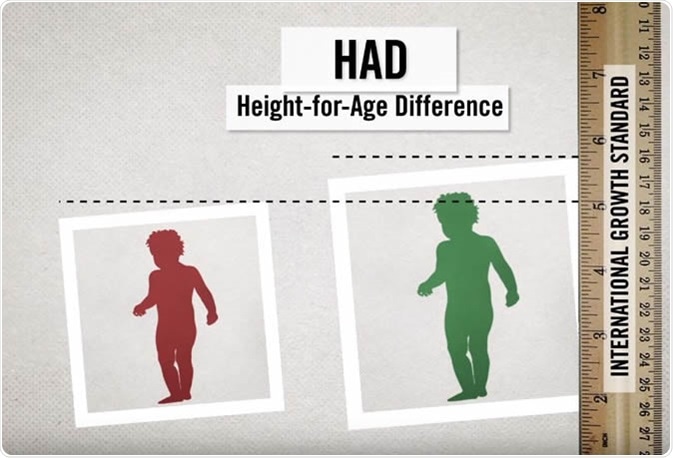
Risk Factors for Stunted Growth
Stunting is the severe shortening of length in young children (or height in older children) to less than 2 standard deviations below age-specific medians. It has important consequences for the health of more than 178 million children in developing countries who experience a four-fold increase in mortality before age 5.

It is well known that a stunted child fails to develop properly, and that a population with a high percentage of stunted children fails to achieve optimal levels of physical and intellectual growth and development.
These children also fail to show normal expected rates of economic growth and productivity, earning on average one-fifth less than their non-stunted peers. Areas affected by widespread stunting may experience a national reduction in GDP by as much as 3% to 6%.
Incidence of Stunting
Almost one-third of children below the age of 5 years are stunted in developing regions of the world. Furthermore, stunting is the cause in 14% of childhood deaths. Studies have reported a number of risk factors for stunting, the most important of which are presented below.
Fetal Factors
Preterm birth (before 37 weeks of gestation) and fetal growth restriction (FGR), which refers to a birth weight below the 10th percentile for the term of gestation, are the leading risk factors for stunting. FGR, is present in about 25% of all cases of stunting.
If a fetus fails to receive adequate food for more than a transient period, it appears unable to regain growth momentum later with supplementary feeding. A 1-point length-for-age score increase at birth is associated with a 60% decreased risk of stunting between the first and second years.
An accurate measurement of length at birth is the most reliable measurement in predicting childhood stunting.
Maternal Factors
Maternal malnutrition (body mass index less than 18.5, anemia, and height less than 160 cm) and malaria infection are important in utero contributors to stunting, which is characterized by low birth weight and infant length less than the 5th percentile.
Teenage pregnancy and short intervals between births (less than 24 months) also increase the risk for offspring stunting.
Childhood Nutrition and Infection
Male infants and children are twice as likely to be stunted compared with female children, and they experience the stunting earlier and to a greater degree. Baby boys become sick and die much more often than baby girls under the same conditions, especially if they are born early.
Because boys typically grow faster than girls, they are greater risk for stunting compared with girls when malnourished.
Stunting tends to increase with age, with 14% of children being stunted at 6 months compared with 46% at 18 to 23 months in one study. Stunting is almost twice as common at 18 and 24 months than at 12 months.
Exclusive breastfeeding is recommended during the first 6 months of life. Children who are not exclusively breastfed until 6 months and those who do not continue to breastfeed at 2 years are at increased risk of health problems.
Breastfeeding supplies about one-half of energy requirements in healthy babies at 1 year of age and one-third of energy requirements at 2 years of age. The remaining energy requirements must be supplied by energy-dense complementary feeding. Failure to achieve this affects growth and development.
Moreover, infections such as childhood diarrhea or HIV affect growth potential. Zinc deficiency is another leading risk factor for this group.
Environmental Factors
Diarrheal disease, often due to poor sanitation, is another leading cause of stunting. The absence of proper sanitation can be traced to about 7 million cases and diarrhea to about 6 million cases of stunting.
Environmental factors such as lack of food security, and unavailability of potable water and sanitary facilities for toileting and washing, and lack of hygienic measures all contribute to diarrheal disease.
Children of poor parents are 3-times more likely to be stunted than those whose parents earned a middle-class or upper-class income. This finding likely reflects food insecurity, low educational levels, lack of knowledge about nutritional health, and poor access to healthcare among poorer families.
Poverty also plays a synergistic role with negative environmental factors to endanger children’s health and lives as a result of stunting.
Environmental factors are the second leading cause of stunting in some developing areas of South and East Asia, Pacific regions, and sub-Saharan Africa.
Conclusion
Reducing the rate of stunted growth in children the world over requires investing in measures to improve maternal health and environment. This long-term endeavor requires a variety of strategies to improve family nutrition and food security.
Universal access to better sanitation will help control childhood diarrheal disease and associated malnutrition and stunting.
Nutritional needs in infancy require both an active promotion of breastfeeding and education about complementary feeding with a proper supply of nutritional food.
These measures can prevent the deaths of over 220,000 children under the age of 5.
Last Updated: Nov 20, 2018























.png)









No hay comentarios:
Publicar un comentario